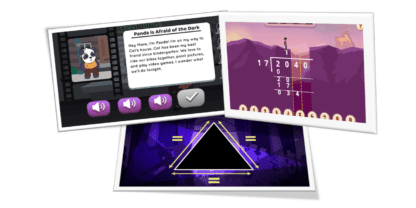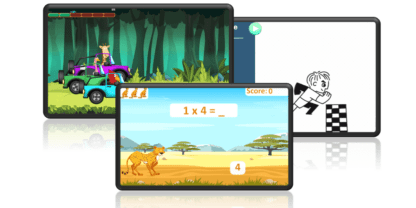One of the biggest challenges that teachers face is keeping kids engaged. Older learners – even older elementary school learners – are hard to excite. A lesson plan you hoped would last a whole hour might be completed in a few minutes Your kids can grow bored and distracted easily, making it harder for you to manage the classroom.
You need foolproof lesson plans to keep your students engaged. Here are a variety of reading activities to build into your classroom and modify based on what your students want. Use these options to jazz up your reading class and help kids connect better with the material.

1. Create Story Trains
As students reach the older elementary years, they should be able to pick up on the elements of a story. They should also be able to identify foreshadowing and pick out plot twists, climaxes, and resolutions. Use this story train activity as a written game of telephone. One student starts the train by writing a few sentences of a story. The next student adds a conflict. The next one adds a plot twist or supporting information and the train keeps going until the final student concludes with a resolution.
You can make this a single-lesson project where students build stories in groups or you can create a month-long writing challenge (NaNoWriMo anyone?) where each student gets a different story to build on each night. Students have to read each other’s stories and receive a completed tale by the end of the month.
2. Use Visual Organizers for Persuasive Writing
Older learners might start to engage with persuasive reading and writing within the curriculum. They might read a speech and highlight the elements that make it persuasive. Consider adopting a visual organizational format to help students identify opinions and separate the supporting arguments, conclusion, and call to action.
Check out the chart by 2 Kinder and Beyond as an example. This layout can help students draft persuasive essays, but it can also help them dissect information they encounter on social media. How is a fun video on TikTok also trying to persuade kids toward a cause? How is a post on Instagram making an argument for or against something? Persuasion is everywhere around us and visual charts can help kids identify it.
3. Tap Into Riddles, Limericks, and Other Word Games
Reading activities can help you track whether students are completing their assignments without asking them to keep an outdated reading journal. Rather than asking kids to reflect on their feelings or write summaries on assigned content each night, challenge them to create fun riddles or poems based on the information. You can read the top riddles to the class or let your students share their creations with their peers.
Other fun assignments to check for reading completion include acrostic poems, comic strips, and wanted posters, which students can create to show they are actively reading each night.
4. Ask Students to Write Alternate Endings
As your upper elementary students read more books, they will start to realize how heartbreaking stories can be. Not every tale has a happy ending and authors might draft a plot that frustrates readers. If you know that your class is about to read a particularly sad book (like Where the Red Fern Grows) consider allowing them to write alternate endings after they complete the story. You can also give out this assignment to books with happy endings and challenge students to write a scarier version – potentially as a Halloween assignment – or a setup for a sequel.
This activity can turn students into authors and help them realize how hard it is to draft a story without loose ends which also makes the audience happy.
5. Play Reading Comprehension Jenga
If you have ever grouped your students together to discuss a book, you might find that one of two things happens: your students either provide one-word answers to the questions you provide or they get distracted and talk about something completely unrelated to the class.
Jenga can help students stay focused on a discussion and increase the energy in the room. Each piece has a question about the characters, plot, setting, or other elements of the story. Your students will pull out a piece, read the question, and answer it. The goal is to build a high tower without anything tipping over.
Depending on your current resources, you can play this as a class or in smaller groups. You can also create Reading Comprehension Connect Four, War, and other games that students can play together.
6. Create Social Media Journals
Another way to make sure students are reading each night or keeping up with their assignments is with social media journals. Students can create mock Facebook or Instagram posts pretending to be the characters they are reading. The students can share plot updates while pretending to be the characters or reflect on their motives and future actions. By the end of each book, students should have a story told through a series of social media posts.
Check out the book Twitterature as an example. Hamlet, Harry Potter, and various other books are told through a series of 20 tweets per book. This is a way to highlight key plot points and reflect on the story without asking students to write out several journal entries.
7. Don’t Forget Read Alouds
Older students don’t get storytime as often as younger learners. They usually have to read on their own as part of their homework assignments. However, hearing words spoken aloud can help students get an idea of the tone of the story. They can help students move beyond sounding out words so they can dive deeper into the plot. Plus, some authors write with the goal of hearing their words spoken – especially poets and playwrights.
Read-alouds are a good way to end the day. They can keep students focused during the final minutes before they go home and they can also serve as a tease to excite students about the story. If you can hook your kids with a read-aloud in the last 10 minutes of the day, then they are more likely to keep reading on the bus ride home or once they finish with their after-school activities.
Use Upper Elementary Reading Activities to Make Literature Fun
Older students have to read more advanced books and you may find that some students stop reading for fun. Your students are going to start engaging with more literature – especially as they leave for middle school. These reading activities can keep students engaged in the stories and the materials you need to teach. Reading can be less overwhelming or boring and more fun.



